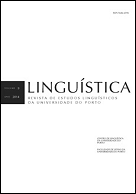Edith A. MORAVCSIK. Introducing Language Typology. Cambridge: Cambridge University Press. 2013. xiii+308 pp. ISBN: 978-0-521-15262-4
Abstract
.
References
Baker, M. C. 2001. The Atoms of Language: The Mind’s Hidden Rules of Grammar. New York: Basic Books.
Bakker, D. 2011. Language sampling. In: J. J. Song (Ed.). The Oxford Handbook of Linguistic Typology. Oxford: Oxford University Press, 100-127. Citado por Moravcsik, E.
A. 2013. Introducing Language Typology. Cambridge: Cambridge University Press. Blevins, J. 2007. The importance of typology in explaining recurrent sound patterns. Language Typology.11: 107-113.
Chomsky, N. 1981. Lectures on Government and Binding.Dordrecht: Foris.
Chomsky, N. 1986. Knowledge of Language: Its Nature, Origin, and Use. New York: Praeger. Trad. port.: A. Gonçalves, A. T. Alves. O Conhecimento da Língua. Sua Natureza, Origem e Uso. Lisboa: Caminho, 1994.
Croft, W. 1990. Typology and Universals. Cambridge: Cambridge University Press. Dressler, W. U. 1979. Reflections of phonological typology. Acta Linguistica Academiae Scientianrum Hungaricae. 29(3-4): 259-273.
Evans, N. & Levinson, S. C. 2009.The myth of language universals: Language diversity and its importance for cognitive science. Behavioral and Brain Sciences. 32: 429 –492. Greenberg, J. 1966. Language Universals: With Special Reference to Feature Hierarchies. The Hague: Mouton.
Greenberg, J., Ferguson, C. A. & Moravcsik, E. A. (Eds.). 1978. Universals of Human Language: Word structure. Stanford CA: Stanford University Press.
Hammond, M. 2006. Phonological Universals. Encyclopedia of Language & Linguistics (Second Edition). Amsterdam: Elsevier, 525-531.
Haspelmath, M. 2001. Language Typology and Language Universals: An International Handbook. Volume 1. Berlin: De Gruyter.
Haspelmath, M. et al. (Eds.). 2005. The world atlas of language structures. Oxford: Oxford University Press.
Hyman, L. M. 2007. Where’s phonology in typology? Language Typology.11: 265-271 Kirby, S., Smith, K. & Brighton, H. 2007. From UG to Universals. Linguistic adaptation through iterated learning. In: M. Penke, A. Rosenbach (Eds.). What Counts as Evidence in Linguistics: The Case of Innatenes. Amsterdam: John Benjamins, 587-607.
Prince, A. & Smolensky, P. 2004. Optimality Theory: Constraint Interaction in Generative Grammar. Cambridge: Blackwell.
Downloads
Published
Issue
Section
License
Copyright (c) 2017 Linguística Revista de Estudos Linguísticos da Universidade do Porto

This work is licensed under a Creative Commons Attribution-NonCommercial 4.0 International License.



